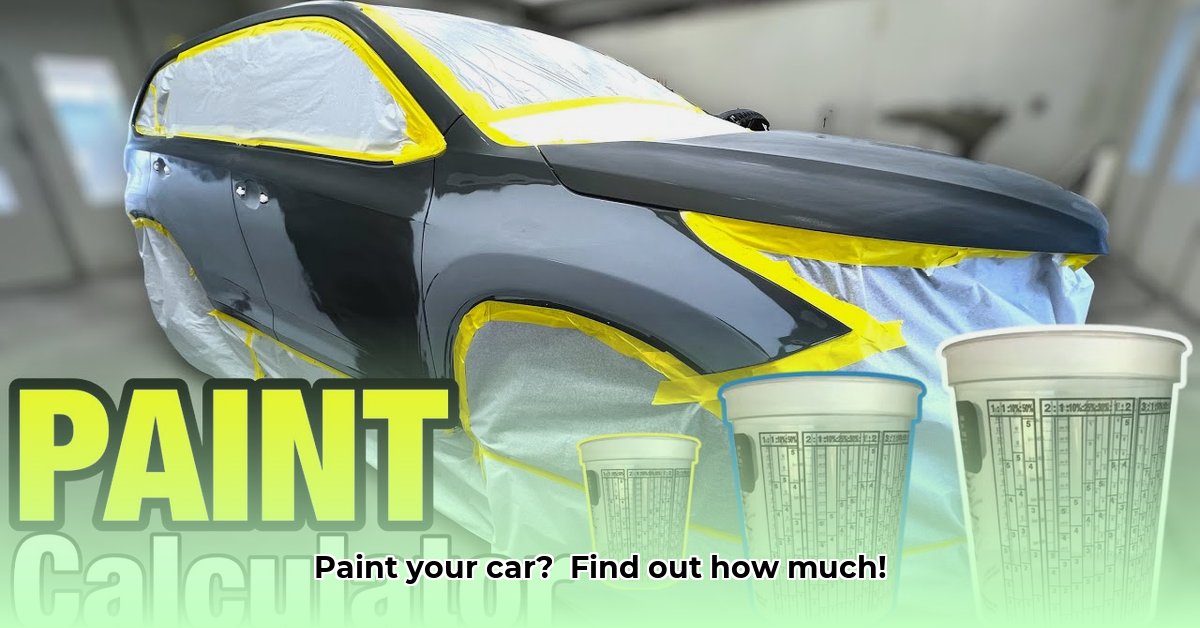
Painting your car can be a rewarding experience, but accurate paint estimation is crucial for a successful project. Underestimating paint leads to frustrating delays, while overestimating results in wasted money. This guide provides a step-by-step process for calculating the exact amount of paint you'll need, ensuring a smooth and efficient paint job.
Step 1: Measuring Your Car's Surface Area
Accurately determining the paintable surface area is the first step. This is best achieved through a combination of methods:
Geometric Approximation: Divide your car into simple shapes (rectangles, triangles) using a measuring tape. Calculate each section's area and sum them for a total. This method offers high accuracy but requires patience and attention to detail. Remember to exclude non-paintable areas like windows, tires, and bumpers (unless you're painting them). Consider sketching your car to help visualize these measuring sections.
Online Calculators: Many websites offer car paint calculators that estimate surface area based on make, model and year. While convenient, these results are approximations, and should be treated as a starting point for your calculations.
Professional Measurement: For the most precise results, consider hiring a professional automotive painter. They have the experience and tools to provide extremely accurate measurements. This is the most expensive option, though.
Don't forget to account for all surfaces you intend to paint. Will you be painting under the hood, for example?
Step 2: Determining Paint Coverage
Paint coverage varies significantly depending on type and brand. Always consult the manufacturer's label for precise coverage rates (usually expressed in square feet per gallon or square meters per liter).
Single-Stage Paint: This combines color and clear coat in one application. It usually offers a lower coverage rate (approximately 250-350 sq ft/gallon).
Basecoat/Clearcoat: This two-part system provides a more durable and glossy finish. While more expensive, it often has a higher coverage rate (approximately 300-400 sq ft/gallon). Remember you need both coats to be included in your final calculation.
Primer: Don't forget the primer! You'll need to account for this in your total paint needs. The primer’s coverage rate will be found on its own can.
Do the higher upfront costs of basecoat/clearcoat justify the potential savings on paint volume?
Step 3: Determining the Number of Coats
Multiple coats are crucial for a professional finish. Typically, two to three coats are used, with a primer often being applied first. Multiply your total surface area by the number of coats needed to get the total paint needed for coverage (including primer if you are planning on using it).
- How many coats are needed to achieve the desired depth of color and durability?
Step 4: Calculating the Overage Factor
Inevitably, some paint will be lost to overspray, drips, and touch-ups. To account for waste and ensure you have enough paint, add an overage factor to your calculations.
Beginners: Aim for a 20-25% overage to allow for mistakes and extra paint.
Experienced Painters: A 10-15% overage is usually sufficient.
Does your experience level justify a lower overage percentage?
Step 5: The Final Calculation
Now, let's calculate your total paint needs:
Calculate Total Paintable Surface Area (Step 1): This is your starting point.
Determine the Number of Coats (Step 3): Multiply the surface area by the number of coats required.
Apply the Overage Factor (Step 4): Multiply the total square footage from Step 2 by your chosen overage factor and add the result to the total square footage from Step 2.
Divide by the Coverage Rate: Divide the final number from Step 3 by the paint's coverage rate (found on the manufacturer's label) and Round up to the nearest whole gallon or liter.
Example:
Let's say your car's surface area is 200 sq ft, you're using two coats, you've decided on a 15% overage factor, and your paint covers 300 sq ft/gallon.
200 sq ft (surface area) x 2 (coats) = 400 sq ft
400 sq ft x 0.15 (overage) = 60 sq ft
400 sq ft + 60 sq ft = 460 sq ft
460 sq ft / 300 sq ft/gallon = 1.53 gallons → Round up to 2 gallons.
Step 6: Advanced Considerations
Several factors can fine-tune your calculation:
Paint Viscosity: Thicker paints may require less, but thinner paints might require more.
Environmental Conditions: High temperatures and humidity can impact drying time and coverage, potentially increasing wastage. Paint can dry too quickly with high heat.
Spray Equipment: Higher-quality spray equipment results in better coverage and less wastage.
Step 7: Tips for Reducing Waste
Practice: Refine your spray techniques on scrap materials before painting your car.
Equipment: Invest in quality spray equipment.
Masking: Use masking tape to prevent overspray.
Cleanliness: Regularly clean your spray gun.
Step 8: Choosing the Right Paint
Consider the car type, desired finish, budget, and environmental factors (VOCs) when selecting paint. Low-VOC paints offer a more environmentally friendly alternative.
Conclusion
Accurate paint estimation ensures a successful and cost-effective paint job. This guide provides a comprehensive framework; however, always double check manufacturer specifications and test your calculations on a small area before committing to the entire project. Share your experiences and results in the comments below!